Athletes regularly participate in rigorous training and competition. While they routinely stretch and exercise accordingly to prevent experiencing injuries while performing their specific sport of physical activity, they constant and repetitive movements of the body can often cause damage or injury, even developing an aggravating condition regardless of the process they follow to avoid harm. Hamstring injuries are recognized as frequent injuries among athletes, particularly due to the use of the legs in a majority of sports or physical activities.
Hamstring injuries are significantly common in athletes and the risk of re-injury is reasonably frequent. Researchers found that in elite-level Australian football, hamstring injuries were the most prevalent type of sports injury which required time away from competition. Researchers also determined that low-grade muscle strains occur most frequently, followed by more significant myotendinous junction tears. Fortunately, these have shown a positive response to conservative rehabilitation. Hamstring avulsions are considerably rare, same as complete ruptures originating at the hamstring. Such type of sports injuries can be debilitating.
Muscle ruptures in the form of hamstring avulsions have been reported more frequently in the younger population due to an immature epiphyseal growth plate found on the ischial tuberosity in older children and adolescents. Hamstring avulsions in adults with fully fused ischial tuberosities are contributed to be ruptures of the proximal hamstring tendon or complete avulsion fractures of the ischial tuberosity.
An immediate diagnosis following proper treatment methods for ischial tuberosity avulsions or tendon ruptures is essential at this point because several individuals whom were treated non-operatively for hamstring ruptures experienced residual loss of power. Further complications for hamstring avulsions include pain, weakness, cramping during locomotion and pain while sitting. As with the majority of tendon avulsions, treating the injury as soon as possible can present better outcomes than delaying treatment. According to research, receiving treatment within four weeks of injury resulted in better recovery outcomes as compared to those which received treatment after four weeks of injury.
Table of Contents
Anatomy of the Hamstring & its Function
The hamstring muscles consist of the biceps femoris, both the long head and the short head, the semitendinosus and the semimembranosus. All of these muscles, excluding the biceps short head, attach onto the ischial tuberosity. The short head biceps begin along the femur simultaneously with the linea aspera.
At the proximal origin, the long head of the biceps and the semitendinosus form a combine to create the tendon which attaches to the ischial tuberosity and the semimembranosus.
When an individual undergoes puberty, a secondary ossification center at the ischial tuberosity develops without fusing until the individual’s late teens or early twenties. Within the period of time between the fusion of the apophysis, an increased force traction may cause a hamstring avulsion along the apophysis as a result of a weakened connection between the bone and the muscle. After the bones begin to mature, injuries at the myotendinous junction become more common.
The structures of the hamstring greatly associate with the passage of the sciatic nerve along the upper posterior thigh. A severe injury to the muscle that causes a large hematoma may develop adhesions in and around the sciatic nerve which may create complications towards an athlete’s overall performance after the rehabilitation process. Also, the nerve may become damaged or injured as a result of a traction neuritis when the muscle belly retracts away from the nerve. Furthermore, compression or impingement due to a tight fibrotic band distal to the ischial tuberosity may also cause complications for many athletes. Managing hamstring avulsions and other types of injuries relating to the proper function and mobility associated with the sciatic nerve is an important factor towards overall recovery.
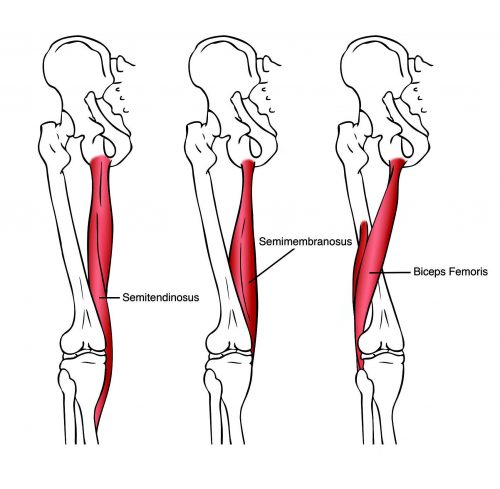
It is not uncommon for hamstring avulsions to involve only two heads of the hamstring and not all three. These are identified as partial avulsions. It is more common if the hamstring avulsions are partial to where it involves the combined tendon of the biceps femoris and the semitendinosus.
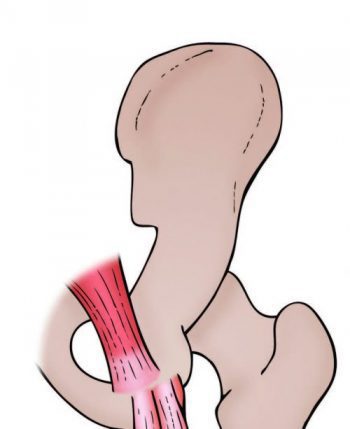
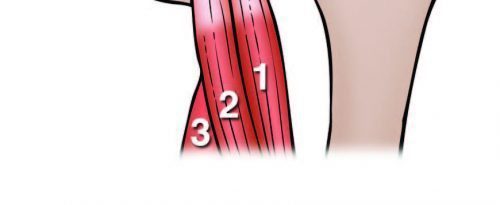
Mechanism of Injury
Due to the anatomical structure of the hamstrings, these can be highly vulnerable to suffer trauma or injury in the regions where the muscles and other tissues cross both the hip and knee, primarily because of its large leverage to function with the hip during movements.
The most common mechanism of injury involves forced knee extensions in a position of hip flexion while the muscle is placed under a large and rapid eccentric load. The force is conducted to the myotendinous junction. This often results due to a sudden and forceful landing from a jump where the knee was locked in extension, during foot contact in sprinting or in excessive and uncontrolled hip flexion, such as when the leg slips out from underneath the body and moves into hip flexion with the knee extended during sports or physical activities like forward splits, water skiing and bull riding.
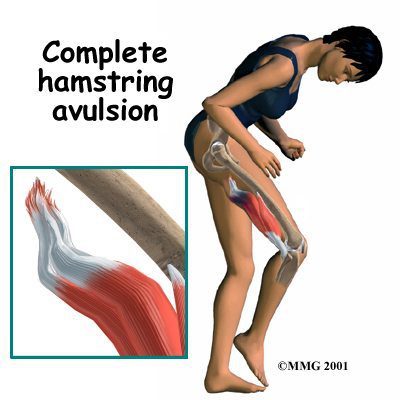
Nonetheless, it’s been considered that in order for tendons to rupture, some level of degenerative alterations must have developed in the tendon before the rupture occurred. This hypothesis has been identified in athletes where the Achilles tendons rupture and the supraspinatus tendons rupture. Researchers have associated these findings with why myotendinous ruptures in the hamstrings of young athletes almost never occur, how they fail at the growth plate as well as explaining its increasing frequency in middle aged, recreational athletes.
The degeneration of the tendon occurs throughout the anatomical and biochemical change in the tissue of the tendon. The collagen fibers become disorganized, the intracellular matrix changes, cystic foci develop in the tendon and hypervascularity within the tendon becomes present. Tension and compression forces being applied against the body can often create these degenerative effects. The forces of tension occur as a result of a rapid, eccentric loading against the hamstring tendon as the hip is rapidly flexed. The forces of compression occur when the singular anatomy of the ischial tuberosity bone presses against the tendon and creates a zone of impingement. Repetitive and constant tension and compression forces then progressively degenerate, eventually becoming weaker and rupturing.
Furthermore, because of the proximity of the hamstring muscles to the sciatic nerve which runs down each leg from the lower back, a hamstring rupture could also affect this crucial nerve. As a result, the inflammation and swelling caused by an injury to the hamstring muscles and other surrounding tissues may compress the sciatic nerve, leading to symptoms of sciatica. Sciatica is commonly referred to as a series of symptoms rather than a single injury and condition. Therefore, athletes with hamstring avulsions may additionally experience symptoms of sciatica.
The affected athlete must seek immediate medical attention not only to effectively treat hamstring injuries but also to determine the presence of sciatica and properly diagnose whether another type of injury or underlying condition may be causing the sciatic nerve pain besides the hamstring rupture.
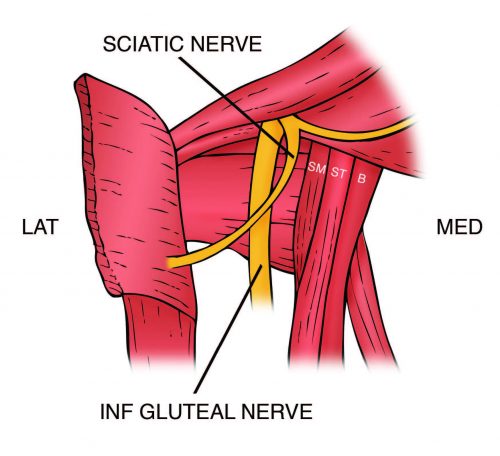
Hamstring Injury Symptoms
Athletes with hamstring avulsions commonly describe experiencing severe and debilitating symptoms after the injury. Many athletes report the pain as a sudden shot along with an audible pop. A majority of individuals faced with hamstring avulsions are guarded on the affected limb and are reluctant to bear full weight on a loaded limb. Hamstring ruptures causing sciatica may experience pain along with numbness and tingling sensations, radiating along the lower back, buttocks and thighs. Also, in some cases of injury, an athlete may develop myofascial pain syndrome, a disorder causing muscle pain in seemingly unrelated areas of the body.
When the affected athlete visits a healthcare professional, such as a chiropractor, physical therapist or other specialist, on examination, a palpable defect may be felt below the ischial tuberosity and a loss of the contour of the hamstring can often be observed. These, however, generally depend on the size of the gluteals and any intervening adipose tissue which could make direct palpation and visualization difficult. Healthcare specialists usually describe a significant discoloration throughout the hamstring muscle a few days after the injury occurred.
Further evaluation of athletes with hamstring avulsions show weakness in both isolated knee flexion and isolated hip extension along with reported pain. The individual’s range of motion is greatly restricted due to the symptoms and walking with a limp may be common as they may be unable to bear weight through the injured muscle.
If proper medical attention is delayed because the injury appears to be muscle related and the athlete believes it could heal on its own, the individual may experience hamstring muscle atrophy due to disuse.
Imaging
Basic X-rays and CT scans won’t provide beneficial results unless the hamstring avulsions occurred from the ischial tuberosity.
Ultrasound imaging may be useful, however, further research regarding its sensitivity and specificity requires more research.
MRI is the preferred method when the presence of a hamstring rupture is suspected because the details of the soft tissues are well displayed on an MRI, highlighting the level of tendon retraction as well as any interference with the sciatic nerve. Furthermore, MRI can be utilized throughout all stages of rehabilitation to evaluate the healing capacities of the tendon.
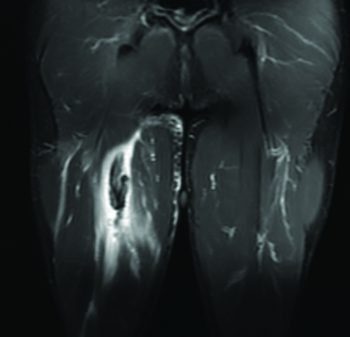
Hamstring Injury: Common Sports Injuries
Hamstring Lesion Treatment & Care
The treatment procedures for hamstring injuries have long been considered controversial, whether they effectively repair or don’t repair the damage or injury. A large number of criteria has been suggested to help healthcare professionals, such as chiropractors and physical therapists, among others, to help determine if athletes faced with hamstring avulsions may require surgery.
First, the osseous avulsion must have more than a 2 cm retraction. Second, there must be complete tears in all 3 tendons with or without retraction, and last, partial tears reporting painful and symptomatic despite prolonged conservative treatment, are some of the criteria an individual must meet to signal the need for surgery.
However, some partial or complete ruptures of the hamstring generally requires some form of operative treatment among the vast majority of athletes, primarily due to concerns regarding residual loss of strength and power.
Instances where partial hamstring ruptures may require operative treatment still remain fully unclear. In some cases, partial ruptures may rehabilitate properly through conservative procedures but if pain and other symptoms continue after a prolonged period of rehabilitation, then repairing a partial rupture through operative measures may lead to positive outcomes.
Surgical Intervention for Hamstring Ruptures
The surgical procedure for repairing hamstring avulsions is as follows: First, the hamstring muscle is contacted with a posterior incision beginning at the gluteal fold. The incision may extend over a 10 cm distance in order for the specialist to be able to fully access the retracted hamstring tendon. The placement of the posterior cutaneous nerve and the sciatic nerve in relation to the individual will be visualized and any adhesions at this point can be carefully resected, a process known as neurolysis. Neurolysis is almost always essential if surgery has been delayed due to misdiagnosis or following unsuccessful conservative treatment procedures. If a hematoma is detected, then this will be cleared.
The end piece of the proximal tendon on the ischial tuberosity is then located, as is the retracted tendon, and these will be closely located with the knee in flexion to reduce the hamstring stretch. Then, they will be repaired with Ethibond sutures and Merselene tapes. If the tendon has avulsed, then this will be anchored with a titanium self-tapping screw.
The stability of the surgical repair is evaluated by passively flexing the knee 45 degrees to create tension in the muscle and tendon. This allows the specialist to analyze the safety of the individuals range of motion throughout the course of surgery so that rehabilitation exercises and stretches can being early within safe ranges. Furthermore, this will avoid prolonged immobilization which have been shown to lead to considerable amounts of atrophy as well as loss of strength and range in post-operative hamstring repairs.
If hamstring injuries are effectively treated early, the need for a post-operative knee flexion brace is generally not necessary but, if the surgery was delayed, then a post-operative knee flexion brace may be required.
Several researches have attempted endoscopic repairs of hamstring avulsions, stating that this procedure can offer more benefits, such as minimizing scar tissue, superior visualization of the hamstring tendon, decreasing the amount of bleeding and better protection of the neurovascular bundle.
Post-Surgical Results
A majority of studies regarding the outcomes of hamstring tendon repairs through surgery providing the return of the individual’s strength and function have demonstrated that it may be unreasonable to expect an athlete to return to full strength in the hamstring following a surgically repaired hamstring tendon. Although the strength and function of the hamstring may be reduced, the athlete can successfully return to a pre-injury level of competition in most cases.
Researchers found that among individuals with repaired hamstring tendons through surgical procedures, 80 percent of them returned to participate in pre-injury levels of sports or physical activities. Moreover, the individual’s hamstring isotonic strength returned to an average of 84 percent while hamstring endurance returned to an average of 89 percent. Additionally, the researchers found that 90 percent of the hamstring injuries they followed had returned to pre-injury levels of sport or physical activity. All of these reported excellent outcomes in function and isokinetic tests demonstrated that the strength of the hamstring returned to 83 percent at six months as compared to 56 percent at the pre-surgery level. Finally, the researchers reported the evaluated results of seven individuals who underwent operative repair and concluded that the average time they experienced a restoration of function was 8.5 months. By six months of port-operative procedures, six of the seven individuals had returned to pre-operative levels of function.
Hamstring injuries are common complications which occur among a variety of athletes. While the symptoms of the injury can vary depending on the severity of the issue, it’s often reported that hamstring injuries can develop symptoms of sciatica. The sciatic nerve extends from the lower back, down the buttocks and thighs, which is why damage or injury to the legs can generally affect the nerves and  tissues surrounding them.
tissues surrounding them.
For more information, please feel free to ask Dr. Jimenez or contact us at 915-850-0900 .
Sourced through Scoop.it from: www.elpasobackclinic.com
By Dr. Alex Jimenez

TRENDING TOPIC: EXTRA EXTRA: New PUSH 24/7®? Fitness Center
Post Disclaimer
Professional Scope of Practice *
The information on this blog site is not intended to replace a one-on-one relationship with a qualified healthcare professional or licensed physician and is not medical advice. We encourage you to make healthcare decisions based on your research and partnership with a qualified healthcare professional.
Blog Information & Scope Discussions
Welcome to El Paso's Premier Wellness and Injury Care Clinic & Wellness Blog, where Dr. Alex Jimenez, DC, FNP-C, a board-certified Family Practice Nurse Practitioner (FNP-BC) and Chiropractor (DC), presents insights on how our team is dedicated to holistic healing and personalized care. Our practice aligns with evidence-based treatment protocols inspired by integrative medicine principles, similar to those found on this site and our family practice-based chiromed.com site, focusing on restoring health naturally for patients of all ages.
Our areas of chiropractic practice include Wellness & Nutrition, Chronic Pain, Personal Injury, Auto Accident Care, Work Injuries, Back Injury, Low Back Pain, Neck Pain, Migraine Headaches, Sports Injuries, Severe Sciatica, Scoliosis, Complex Herniated Discs, Fibromyalgia, Chronic Pain, Complex Injuries, Stress Management, Functional Medicine Treatments, and in-scope care protocols.
Our information scope is limited to chiropractic, musculoskeletal, physical medicine, wellness, contributing etiological viscerosomatic disturbances within clinical presentations, associated somato-visceral reflex clinical dynamics, subluxation complexes, sensitive health issues, and functional medicine articles, topics, and discussions.
We provide and present clinical collaboration with specialists from various disciplines. Each specialist is governed by their professional scope of practice and their jurisdiction of licensure. We use functional health & wellness protocols to treat and support care for the injuries or disorders of the musculoskeletal system.
Our videos, posts, topics, subjects, and insights cover clinical matters and issues that relate to and directly or indirectly support our clinical scope of practice.*
Our office has made a reasonable effort to provide supportive citations and has identified relevant research studies that support our posts. We provide copies of supporting research studies available to regulatory boards and the public upon request.
We understand that we cover matters that require an additional explanation of how they may assist in a particular care plan or treatment protocol; therefore, to discuss the subject matter above further, please feel free to ask Dr. Alex Jimenez, DC, APRN, FNP-BC, or contact us at 915-850-0900.
We are here to help you and your family.
Blessings
Dr. Alex Jimenez DC, MSACP, APRN, FNP-BC*, CCST, IFMCP, CFMP, ATN
email: coach@elpasofunctionalmedicine.com
Licensed as a Doctor of Chiropractic (DC) in Texas & New Mexico*
Texas DC License # TX5807
New Mexico DC License # NM-DC2182
Licensed as a Registered Nurse (RN*) in Texas & Multistate
Texas RN License # 1191402
ANCC FNP-BC: Board Certified Nurse Practitioner*
Compact Status: Multi-State License: Authorized to Practice in 40 States*
Graduate with Honors: ICHS: MSN-FNP (Family Nurse Practitioner Program)
Degree Granted. Master's in Family Practice MSN Diploma (Cum Laude)
Dr. Alex Jimenez, DC, APRN, FNP-BC*, CFMP, IFMCP, ATN, CCST
My Digital Business Card


